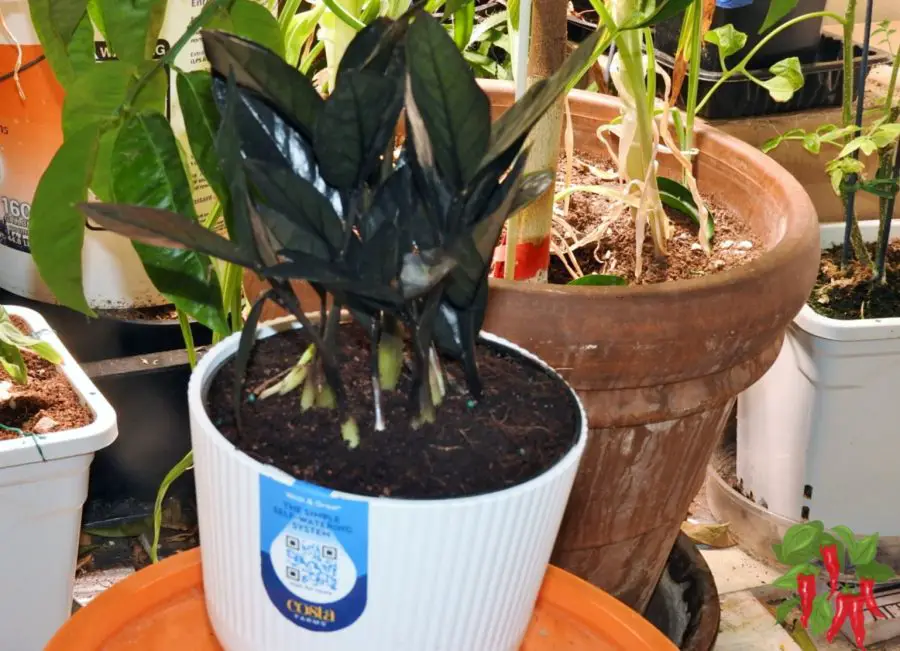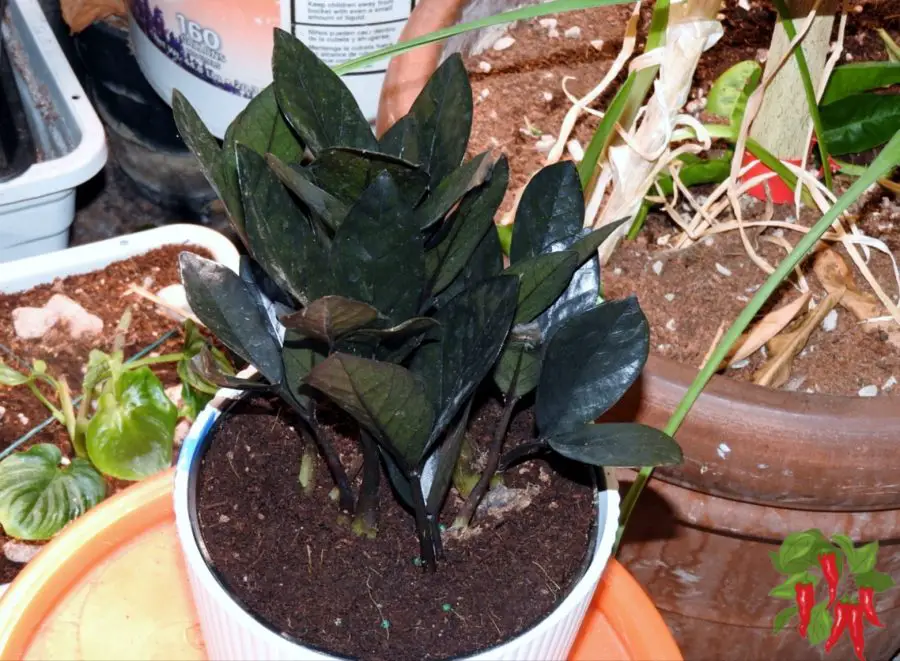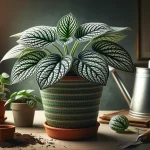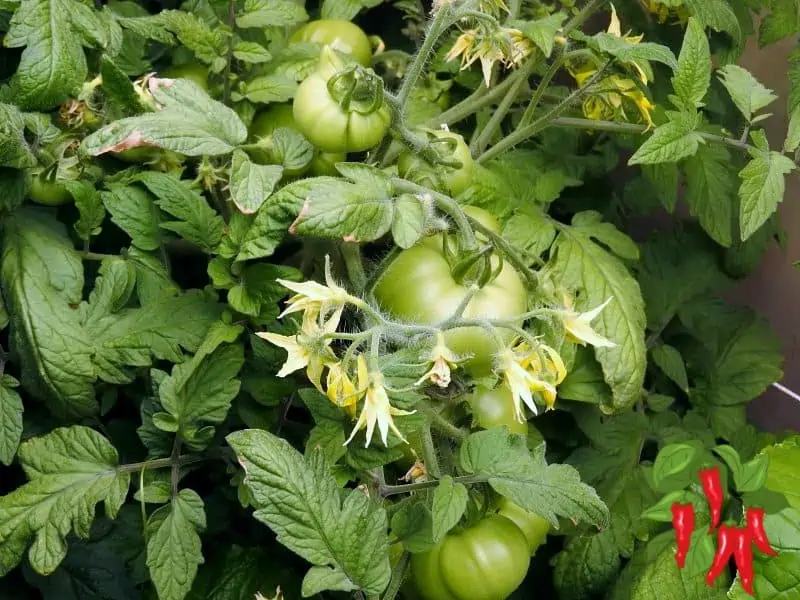This post may contain affiliate links. If you buy something from one of our links we may earn a commission. Thanks

Want to nail Raven ZZ Plant care but worried you might mess up? While these gorgeous black plants might look like they need special attention, they’re actually one of the most forgiving houseplants you can grow.
In this guide, I’ll show you exactly how to keep your Raven ZZ thriving with minimal fuss – even if you’ve got a less-than-perfect track record with plants.
Raven ZZ Plant Care Key Takeaways:
- Raven ZZ Plant care is straightforward and low-maintenance.
- Water only when the top 2-3 inches of soil feels dry.
- Place in medium to bright indirect light.
- Use well-draining soil and a pot with drainage holes.
- These hardy plants tolerate low light conditions and irregular watering.
- This makes them perfect for busy plant owners or office environments.
Raven ZZ Plant for Sale

Costa Farms Raven ZZ Plant, Easy Care Indoor Houseplant, Ships in Modern White Decor Planter with Soil, Perfect Room Decor for Tabletop, Shelf, or Desk, Trending Tropicals Collection, 10-Inches Tall
1. Introduction: Raven ZZ Plant Care

The Raven ZZ Plant has taken the houseplant world by storm with its mysterious, dark foliage and incredible resilience.
This stunning variety of the popular ZZ Plant (Zamioculcas zamiifolia) offers a unique twist with its nearly black leaves, making it perfect for modern home decor.
Whether you’re a seasoned plant owner or just starting your green journey, this guide will help you master Raven ZZ Plant care.
• One of the most striking indoor plants available today
• Perfect for both beginners and experienced plant enthusiasts
• Highly adaptable to various indoor environments
• Excellent choice for adding drama to any room
2. Black Raven ZZ Plant
The Raven ZZ Plant stands out in the houseplant world as a true botanical marvel. This patented variety, developed by Costa Farms, transforms from bright green new growth to a deep, mysterious purple-black color that can add instant sophistication to any space. Its unique coloring process makes it a fascinating plant to watch as it grows and develops.
• Features glossy, dark purple-black leaves when mature
• New growth emerges bright green before darkening
• Can grow up to 30 inches tall indoors
• Native to Eastern Africa, like its green counterpart
• Maintains its color even in lower light conditions
3. Raven ZZ Plant vs. Regular ZZ Plant
While both plants share the same easy-care nature, the Raven ZZ Plant offers a dramatic twist on the classic variety.
Understanding the differences and similarities between these two plants can help you choose the right one for your space and create stunning plant combinations in your home.
• Raven variety has darker foliage compared to the regular green ZZ
• Both types have similar growth rates and care requirements
• Raven ZZ tends to be slightly more compact
• Both varieties show excellent drought tolerance
• Raven variety often commands a higher price due to its unique appearance
4. Raven ZZ Plant Care Indoors
Taking care of indoor plants doesn’t get much easier than the Raven ZZ Plant.
This hardy houseplant thrives in typical indoor conditions and forgives occasional neglect, making it perfect for busy households.
Whether you’re placing it in your home office or living room, these care guidelines will help your plant flourish.
General Care Guidelines:
• Prefers temperatures between 65-80°F (18-27°C)
• Tolerates normal household humidity levels
• Can adapt to various light conditions
• Grows slowly but steadily when properly cared for
Seasonal Care Adjustments:
• Reduce watering in winter months
• Scale back fertilizer during the dormant period
• Protect from cold drafts near windows
• Monitor soil moisture more closely in summer
Pest and Disease Resistance:
• Naturally resistant to most common houseplant pests
• Rarely affected by diseases
• Watch for occasional mealybugs or scale insects
• Regular inspection helps prevent issues
5. Raven ZZ Plant Benefits
Beyond its striking appearance, the Raven ZZ Plant offers numerous benefits that make it an excellent choice for any indoor space.
This versatile plant combines beauty with practical advantages, making it a valuable addition to both homes and offices.
• Excellent air-purifying abilities
• Thrives in low-maintenance conditions
• Perfect for offices with artificial lighting
• Adds dramatic contrast to plant collections
• Helps reduce stress and boost productivity
• Ideal for spaces with limited natural light
6. ZZ Plant Water Requirements
Water management is crucial for keeping your Raven ZZ Plant healthy. These plants are drought-tolerant thanks to their thick rhizomes, which store water like a camel’s hump.
Understanding their watering needs will help prevent the most common care mistakes.
• Water only when the top 2-3 inches of soil feels dry
• Allow soil to dry between waterings
• Reduce watering frequency in winter
Watch for signs of overwatering:
• Yellowing leaves
• Soft, mushy stems
• Root rot
Signs of underwatering:
• Wrinkled leaves
• Drooping stems
• Slow growth
7. Raven ZZ Light Requirements
While the Raven ZZ Plant can survive in low light, providing the right amount of light will help maintain its stunning dark coloration and promote healthy growth.
Understanding its light preferences will help you choose the perfect spot for your plant.
• Best growth in bright, indirect light
• Can tolerate low light conditions
• Avoid direct sunlight which can burn leaves
• Position 3-6 feet from sunny south windows or use sheer curtains
• East windows work well
• Artificial light works well for this plant
• Rotate plant quarterly for even growth
8. ZZ Plant Fertilizer
A little fertilizer goes a long way with the Raven ZZ Plant. These efficient feeders don’t need much supplemental nutrition, but regular feeding during the growing season can help maintain healthy growth and vibrant foliage.
• Use balanced liquid fertilizer (10-10-10)
• Feed every 2-3 months during growing season
• Skip fertilizing in winter months
• Dilute fertilizer to half-strength
• Avoid over-fertilizing which can damage roots
• Flush soil occasionally to prevent salt buildup
9. ZZ Plant Soil
The right soil mix is essential for your Raven ZZ Plant’s success. These plants need well-draining soil to prevent root rot while still retaining enough moisture to support healthy growth.
• Use well-draining potting mix
• Add perlite or coarse sand for better drainage
• Maintain soil pH between 6.0-7.0
Consider these mix ratios:
• 2 parts potting soil
• 1 part perlite
• 1 part coarse sand
• Avoid heavy, moisture-retaining soils
Coco Coir and Perlite Mix
Creating the perfect soil mix is key to your Raven ZZ Plant’s success. These plants thrive in light, airy soil that drains well but still holds enough moisture to keep roots happy.
By using coco coir instead of regular potting soil, you’ll get better drainage and reduce the risk of root rot.
Perfect soil mix ratio:
• 2 parts coco coir
• 1 part perlite
• Optional: 1/4 part worm castings for nutrients
Benefits of this mix:
• Excellent drainage
• Good air circulation for roots
• Natural pest resistance
• Sustainable alternative to peat
Important soil tips:
• Maintain pH between 6.0-7.0
• Always use fresh, clean materials
• Pre-moisten coco coir before mixing
• Avoid garden soil or moisture-retaining mixes
Signs your soil mix is right:
• Water drains quickly through the pot
• Top layer dries between waterings
• Plant shows healthy growth
• No mushy stems or yellowing leaves
10. Raven ZZ Plant Propagation
The process of creating new Raven ZZ Plants can be both rewarding and cost-effective.
While these plants grow slowly, propagation allows you to expand your collection or share this unique plant with friends.
The key is patience, as new plants take time to develop their signature dark coloring.
Leaf Cutting Method:
• Select healthy, mature leaves
• Cut leaves at the base where they meet the stem
• Let cuts callus for 24 hours
• Place leaf 1/2 inch deep in soil or
• Place cut end in clean water
• Change water weekly
• Place in bright indirect light
• Expect roots in 2-3 months
• Transfer to soil when roots are 2-3 inches long
Stem Cutting Method:
• Choose healthy stems with multiple leaves
• Cut 4-6 inch sections with clean shears
• Remove bottom leaves
• Let cuts callus overnight
• Plant in moist soil mix
• Keep soil slightly damp
• Maintain warm temperature (70-75°F)
• Look for new growth in 2-3 months
Division Method (Most Reliable):
• Remove the plant from the pot during repotting
• Gently separate rhizomes with roots attached
• Ensure each section has leaves
• Plant divisions in fresh soil
• Water thoroughly
• Keep in a warm, bright spot
• New growth appears in 4-6 weeks
Tips for Success:
• Always use sterilized tools
• Spring and summer are best for propagation
• Keep cuttings away from direct sun
• Maintain consistent temperature
• Don’t overwater new plants
• Be patient – growth is slow
• Each new leaf starts green before darkening
Common Problems:
• Rotting cuts: reduce moisture
• No root development: check temperature
• Yellow leaves: reduce water
• Failed cuttings: try again with fresher cuts
11. Raven ZZ Plant Repotting
Your Raven ZZ Plant won’t need frequent repotting since it’s such a slow grower. Most plants only need a new home every 2-3 years, and only when they give you clear signs they’re ready for an upgrade.
Think of it like moving to a bigger apartment – you only do it when you’ve outgrown your current space.
When to Repot
You’ll know it’s time for a bigger pot when you notice roots growing through the drainage holes or if the plant becomes unstable and starts tipping over.
Another clear sign is when water runs straight through the pot without being absorbed, or if you notice significantly slower growth even during the growing season.
If your plant seems to need water more frequently than usual, this could also mean it’s time for an upgrade.
Choosing the Right Time
Spring and early summer are ideal for repotting your Raven ZZ Plant. During these seasons, your plant is naturally in a growth phase and can recover more quickly from the stress of repotting.
Try to avoid repotting during winter when your plant is semi-dormant.
Getting Ready
Before you start, gather everything you’ll need: a new pot just 1-2 inches larger than the current one, fresh soil mix, clean scissors or pruning shears, and water.
Make sure your new pot has drainage holes – this is non-negotiable for ZZ plants. Water your plant lightly 24 hours before repotting to make removal easier.
The Repotting Process
Start by gently removing your plant from its current pot. If it’s stubborn, try squeezing the sides of the pot to loosen the root ball.
Once out, take a moment to inspect the roots. Healthy roots should be firm and white or tan. Trim away any soft, mushy, or obviously dead roots with clean scissors.
Carefully loosen the root ball with your fingers. Don’t worry about being too gentle – ZZ plants are tough, and breaking up the roots a bit actually encourages new growth.
Place some fresh soil in the bottom of the new pot, position your plant at the same depth it was growing before, and fill in around the sides with soil mix.
After-Care
Water your newly repotted plant thoroughly until water runs from the drainage holes. This helps settle the soil and eliminates air pockets.
Place it in a spot with bright, indirect light and hold off on fertilizing for about a month to give the roots time to recover.
During the first few weeks after repotting, keep the soil slightly drier than usual. This encourages the roots to grow and search for water.
You might notice your plant looking a bit droopy for a week or two – this is normal transplant shock and should resolve on its own.
Remember: ZZ plants actually prefer to be somewhat rootbound, so don’t rush to repot unless you’re seeing clear signs that it’s needed.
A slightly crowded plant will be healthier than one swimming in too much soil.
12. FAQs About Raven ZZ Plant Care

Understanding common concerns helps you provide better care for your Raven ZZ Plant. Here are the most frequently asked questions about this stunning houseplant.
Q: Why are the leaves of my Raven ZZ Plant turning yellow?
A: Yellow leaves are typically a sign of overwatering, which is the most common problem with Raven ZZ Plants.
Check that your pot has working drainage holes and the soil isn’t staying wet for too long.
Let the top 2-3 inches of soil dry out between waterings, and never let your plant sit in standing water. If the problem persists, consider repotting in a better-draining soil mix.
Q: How long does it take for new leaves to turn black?
A: The color transformation is one of the most fascinating aspects of the Raven ZZ Plant. New leaves emerge bright green and begin their color change after about 2-3 weeks.
The full transformation to that stunning deep purple-black color typically takes 1-2 months. You’ll notice the change happens faster in brighter light conditions, though each leaf may darken at its own pace.
Q: Is the Raven ZZ Plant toxic to pets?
A: Yes, these plants are toxic if eaten. They contain calcium oxalate crystals that can cause significant irritation to the mouth, throat, and digestive system of both pets and humans.
If you have curious pets or small children, place your plant well out of reach. If ingestion occurs, contact your veterinarian or doctor immediately. Symptoms include drooling, oral pain, and swelling.
Q: Does the Raven ZZ Plant need high humidity?
A: Good news for most indoor gardeners – Raven ZZ Plants are perfectly happy in normal household humidity.
You don’t need to invest in a humidifier or spend time misting. These adaptable plants actually prefer average home conditions and can handle dry air like a champ.
While they can survive in bathrooms, the excess moisture isn’t necessary and might even cause problems.
Q: Can the Raven ZZ Plant grow in low light?
A: These plants are remarkably adaptable to low light conditions, which is one reason they’re so popular for offices and dark corners.
While they can survive in low light, you’ll notice slower growth and possibly less intense coloring.
For the best results, provide bright indirect light. Just avoid direct sunlight, which can burn the leaves.
Q: What type of fertilizer works best?
A: Raven ZZ Plants aren’t heavy feeders, so fertilizing is simple. Use a balanced liquid fertilizer (10-10-10) diluted to half strength during the growing season (spring and summer).
Apply every 2-3 months, and skip fertilizing entirely during winter. Remember, it’s better to under-fertilize than over-fertilize these plants.
Q: Why isn’t my plant growing?
A: Slow growth is actually normal for Raven ZZ Plants – they’re naturally slow growers. Growth slows even more during winter months.
However, if you notice absolutely no new growth for several months during the growing season, check the roots for problems, ensure proper light levels, and verify your watering schedule isn’t too heavy or too light.
Q: How should I clean the leaves?
A: Regular cleaning helps your plant photosynthesize better and keeps it looking gorgeous. Simply wipe leaves monthly with a soft, damp cloth.
Clean both the top and bottom of leaves to remove dust. Avoid using leaf shine products or chemical cleaners, as these can damage the plant’s natural protective layer.
Q: When is the best time to prune?
A: Pruning isn’t regularly needed for Raven ZZ Plants, but occasional grooming helps maintain their appearance.
Remove any yellow or dead leaves at the base using clean, sharp scissors. If you need to trim for shape or size, do so in spring or summer when the plant is actively growing. Always make cuts close to the soil level to avoid unsightly stems.
Q: Why are my plant’s stems falling over?
A: Falling stems usually indicate overwatering or root problems. Check the base of affected stems – if they’re soft or mushy, you’ve got an overwatering issue.
Ensure proper drainage, reduce watering frequency, and check that roots aren’t rotting.
Sometimes stems fall over when the plant becomes rootbound, so consider repotting if you haven’t done so in a while.
13. Conclusion
The Raven ZZ Plant brings together the best of both worlds – striking beauty and easy care. This unique houseplant offers a perfect solution for plant lovers seeking something special without demanding complex maintenance routines.
Raven ZZ Plant Key Takeaways
• Stunning Black Foliage:
The Raven ZZ’s most distinctive feature is its dramatic, near-black leaves. New growth starts bright green and gradually darkens to a deep purple-black over several weeks. This unique coloring makes it a standout specimen in any plant collection and creates a striking contrast against lighter foliage plants.
• Incredibly Low Maintenance:
Perfect for busy plant lovers, the Raven ZZ forgives missed waterings and thrives with minimal attention. It can go weeks without water thanks to its drought-tolerant rhizomes and doesn’t need frequent fertilizing or pruning. Just check the soil moisture every week or two, and you’ll have a happy plant.
• Adaptable to Various Conditions:
Whether you’ve got a bright office or a dim corner, the Raven ZZ can handle it. These resilient plants adapt to different light levels, temperature fluctuations, and varying humidity conditions. They’re equally happy in homes, offices, or retail spaces, making them incredibly versatile.
• Perfect for Modern Decor:
The sleek, glossy leaves and architectural growth pattern complement the contemporary interior design perfectly. Their upright growth and dark coloring create dramatic focal points, while their compact nature means they won’t overwhelm smaller spaces. They look particularly striking in light-colored or metallic containers.
• Great for Beginners:
If you’re just starting your plant keeping journey, the Raven ZZ is an excellent choice. It’s forgiving of common beginner mistakes like overwatering or inconsistent care. Its slow growth rate means you won’t need frequent repotting, and its natural pest resistance keeps maintenance simple.
Essential Care Tips for Success:
• Water Management: Allow top 2-3 inches of soil to dry between waterings. Always check soil moisture before watering.
• Light Requirements: Bright indirect light is ideal, but plants adapt to low light. Avoid direct sun which can burn leaves.
• Soil Needs: Use a well-draining mix with plenty of perlite or coco coir. Good drainage prevents root rot.
• Fertilizing Schedule: Feed with a diluted balanced fertilizer every 2-3 months during the growing season only.
• Health Monitoring: Watch for yellow leaves (overwatering), leggy growth (too little light), or pest issues (rare but possible).
Early Problem Detection:
Look for these warning signs to catch issues early:
- Yellowing leaves indicate overwatering
- Drooping stems suggest water stress
- Pale new growth means insufficient light
- Slow or no growth during summer could mean root problems
- Brown leaf tips might indicate fertilizer buildup
Remember: This plant’s beauty lies not just in its striking appearance, but in its ability to thrive with minimal care. When in doubt, it’s better to underwater than overwater your Raven ZZ Plant.
Throughout this guide, we’ve covered everything you need to know about growing and maintaining a healthy Raven ZZ Plant.
With its dramatic appearance and forgiving nature, this plant deserves its place as one of the most sought-after houseplants available today.
Learn more: Indoor Apartment Gardening: 15 Point Comprehensive Guide
Visit my Amazon Influencer Page for videos and gardening products Grow Your Own Garden










